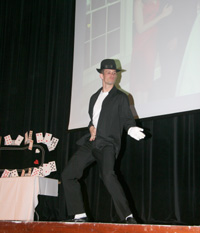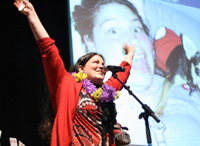 A
total of 135 students with the College of Medicine Class of 2010 took
front stage March 18 during Match Day held at the Charleston Music
Hall. More than 500 family, friends, faculty and staff attended.
This year’s theme borrowed from British writer Ian Fleming’s Casino
Royale. Left
photo: T.G. Nessler danced his way onstage with his rendition of
Michael Jackson’s hit “This is it.” Nessler matched to an emergency
medicine residency at the Carl R. Darnall Army Medical Center in Fort
Hood, Texas. A
total of 135 students with the College of Medicine Class of 2010 took
front stage March 18 during Match Day held at the Charleston Music
Hall. More than 500 family, friends, faculty and staff attended.
This year’s theme borrowed from British writer Ian Fleming’s Casino
Royale. Left
photo: T.G. Nessler danced his way onstage with his rendition of
Michael Jackson’s hit “This is it.” Nessler matched to an emergency
medicine residency at the Carl R. Darnall Army Medical Center in Fort
Hood, Texas.
Match Day occurs the third Thursday in
March each year. Fourth year medical students begin interviewing with residency
programs during the fall of their fourth year. During the month of February
students submit their rank order list with their preference of residency
programs and simultaneously residency programs submit a rank order list with
their preference of students. A computerized algorithm is then used to match
students to programs. Four years of hard work culminates in the
"Match Day" ceremony when students learn the identity of the program to which
they have matched. It is an exciting, anxiety-filled moment, as each student is
called to announce where he or she has matched and learn for the first time
where they will be spending the next one to five years.
 Medical student Allison Garrett is
jubilant after learning that she successfully matched to a psychiatry
residency at the University of Hawaii. Medical student Allison Garrett is
jubilant after learning that she successfully matched to a psychiatry
residency at the University of Hawaii.
The National Resident Matching Program announced that
the 2010 Main Residency Match was one of the most successful ever, breaking
records for the numbers of residency positions offered and filled. There were a
total of 25,520 positions available and 24,378 of them were filled. 82 percent
of matched U.S. seniors matched to one of their first three choice
programs.
MUSC students did
exceptionally well in this year's Match. 135 MUSC students
successfully matched into a variety of specialties from Emergency
Medicine to Child Neurology all around the country at esteemed
institutions like Harvard, Vanderbilt, and the NIH. Twenty-one
percent of our students matched into "competitive match" specialties:
Anesthesiology, Dermatology, Ophthalmology, Orthopaedic Surgery,
Otolaryngology, Plastic Surgery, Radiation Oncology, Radiology, and
Urology. Overall, the most represented specialty was Internal
Medicine (IM) with 24 percent going into IM or a combined IM
residency. Twenty-three percent of students will be completing their
residency training at the Medical University of South Carolina while 77
percent will be going to other institutions. Students will be training
coast to coast (from Cedars-Sinai Medical Center and the University of
Washington to NYU School of Medicine and Johns Hopkins).
Friday, March 26, 2010
|



 A
total of 135 students with the College of Medicine Class of 2010 took
front stage March 18 during Match Day held at the Charleston Music
Hall. More than 500 family, friends, faculty and staff attended.
This year’s theme borrowed from British writer Ian Fleming’s Casino
Royale.
A
total of 135 students with the College of Medicine Class of 2010 took
front stage March 18 during Match Day held at the Charleston Music
Hall. More than 500 family, friends, faculty and staff attended.
This year’s theme borrowed from British writer Ian Fleming’s Casino
Royale. 